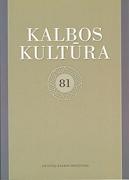Pirmas žvilgsnis į tinklaraščių kalbą
A first glimpse at the language of blogs
Author(s): Rita MiliūnaitėSubject(s): Language and Literature Studies
Published by: Lietuvių Kalbos Institutas
Keywords: Blogs; blog language; lexis; mode of expression; sociolinguistics; medialect; standard language
Summary/Abstract: More than a decade ago the first blogs appeared on the world web (www); around the year 2000 the Lithuanian internet set up its first blogs; in 2006-2007 it witnessed their boom. The article describes blogs as a new internet form of self-expression and communication, its role in social communication and its linguistic expression as well as possible frameworks of linguistic analysis. The article also discusses the problem of coining Lithuanian blog-related concepts and offers an overview of the terms in actual use. The analysis of almost a hundred of blogs produced by authors of different ages and focusing on different topics could hardly lead to any final conclusions and generalisations. However, the pilot linguistic investigation has resulted in identifying some new features of the blog language. The language of blogs is peculiar in that its written form evolves with no mediators or regulators; however, its texts are easily accessible to the public. Therefore, language specialists have a unique opportunity to research actual public written use, to investigate its characteristic features of linguistic expression and functions of the features in the texts. A large variety of blogs, different authors (and the data provided about themselves) give access to investigating the layers and origin of prevalent lexis, dominating modes of expression, specific features of occasional words, how language innovations come into use or are rejected etc. Moreover, all of the above can be related to the social features of the authors and the topics of the texts. The language of blogs can be defined as a new variety of free-style public written language, one of the forms of electronic medium, the so called medialects, and can be discussed alongside with electronic discourse (comments, e-mails, telephone text messages (SMS) and instant messages). The language of blogs functions on the periphery of regulated standard language and beyond its boundaries; it is much more varied. In many cases it is a mixture of elements from different language varieties and different languages (mainly English); therefore, it should not be treated as a perverse form of standard language. In the blogosphere the authors seem to take efforts to publicly negotiate language issues; moreover, the language use is influenced by the public opinion of the readers. Therefore, this language variety cannot be claimed as being completely chaotic. The popularity of blogs and their wide spread would presumably exert major influence on standard Lithuanian and the development of its norms. Thus the language of blogs can be treated as actual use with some obvious new developments, on the one hand, and a possibility to maintain the codification of the standard language or its modification, on the other hand.
Journal: Bendrinė kalba (iki 2014 metų – Kalbos kultūra)
- Issue Year: 2008
- Issue No: 81
- Page Range: 20-49
- Page Count: 30
- Language: Lithuanian

